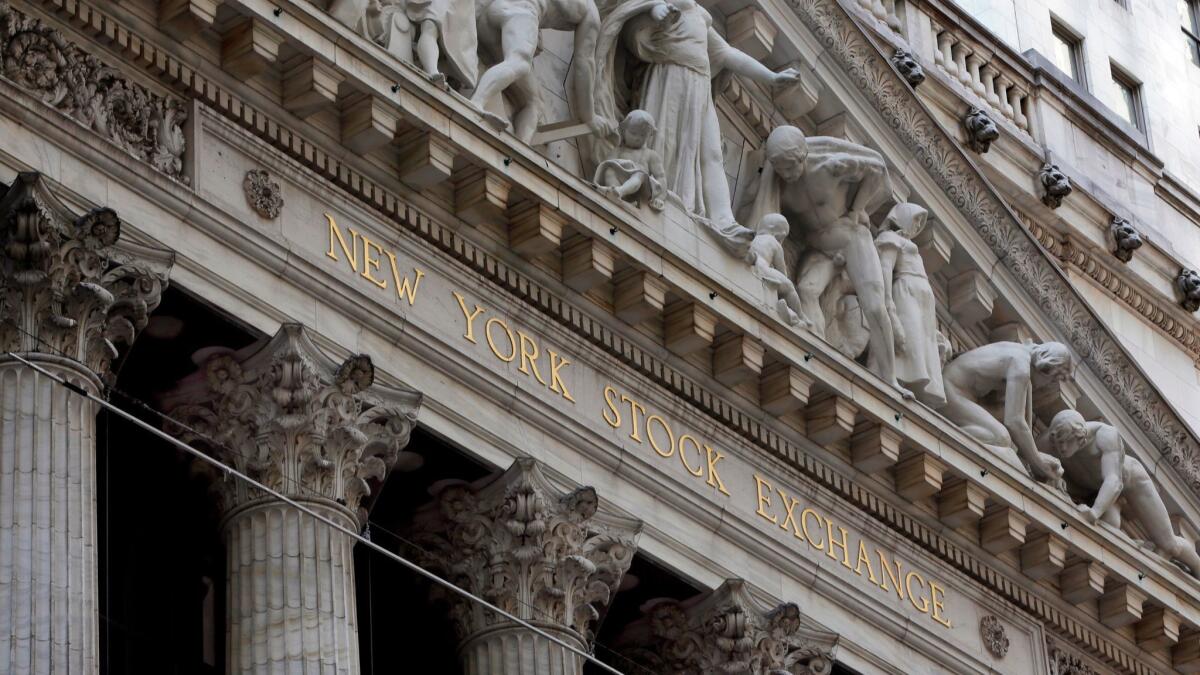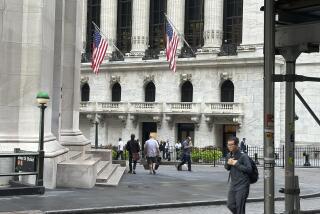Stocks tumble as fears about the U.S. and worldwide economy spread

- Share via
Fears of a steeper slowdown in the global economy rattled financial markets Friday, sending stock prices sharply lower and bond prices higher as investors piled into safer securities.
The stock market has been climbing this year — and celebrated its historic, 10-year-bull rally two weeks ago — after rebounding from a rout last fall on concerns about slowing economic growth and the Federal Reserve’s raising of interest rates.
But the central bank this week abandoned plans to raise rates this year after downgrading its expectations of U.S. economic growth, and other signs surfaced Friday that left investors fretting that economic activity worldwide is slowing further.
The Dow Jones industrial average tumbled 460.19 points, or 1.8%, to 25,502.32 while the benchmark Standard & Poor’s 500 index fell 54.17 points, or 1.9%, to 2,800.71 — its biggest percentage loss since Jan. 3. The Nasdaq composite index dropped 196.29 points, or 2.5%, to 7,642.67.
Bank stocks were among those hard-hit as the prospect of slowing growth and lower interest rates raised concerns about future lending profits. Citigroup Inc. and JPMorgan Chase & Co. each fell 3%.
Technology companies also took heavy losses. Western Digital gave up 6.5%.
Nike Inc. helped drag down the Dow. tumbling 6.6% after the apparel giant reported North American sales in its fiscal third quarter that fell short of analysts’ forecasts.
Boeing dropped 2.8% after Indonesia’s flag carrier became the first airline to seek to cancel an order of 737 Max 8 jets, which have been involved in two fatal crashes in the past six months.
Stocks also fell throughout Europe, with major indexes in Germany, France and Spain losing between 1.6% and 2%, but they mostly rose in Asia.
Investors first were troubled Friday after a report showed factory output in the eurozone fell in March at the fastest pace in six years, and a separate report from the research firm IHS Markit indicated U.S. manufacturing activity in March slipped to its lowest level in 21 months.
Wall Street was also rattled when another signal of a potential slowdown flashed: The yield on 10-year Treasury bonds slipped below that of three-month Treasury bills for the first time since 2007, back when the financial crisis was brewing.
Yield has an inverse relationship to price, decreasing as investors demand for the securities rise. The 10-year note yielded 2.44% — down from 3.2% in early November — while the three-month bill stood at 2.46%, according to FactSet.
That “inverted” yield curve historically is seen signaling a higher risk of a recession, because investors typically are rewarded with higher yields for locking up their money longer when the economy is growing, not the other way around.
Now there’s even talk that the Fed might consider cutting rates again later this year if U.S. economic growth, which was 2.9% last year, slows too abruptly.
But stocks rallied after a similar yield inversion occurred in early December when the yield on five-year Treasury bonds fell below that for two-year bonds for the first time since 2007.
Even as the Fed downgraded its estimate of U.S. economic growth to 2.1% this year, Fed Chairman Jerome H. Powell this week also said the economy “is in a good place, and we will continue to use our monetary policy tools to help keep it there.”
That’s one reason why John Petrides, managing director at Point View Wealth Management in Summit, N.J., said he remains willing “to buy the dips on stocks.”
“The U.S. economy is doing OK, not growing too hot or too cold, and the Fed has done a complete reversal of its monetary policy,” Petrides said. “There’s a big difference between economies slowing and a global recession.
“In addition, look at bond yields, and what incentive is there on an after-tax, after-inflation basis to buy long-term bonds?” he said. “It’s just not there.”
Petrides said the market’s drop Friday also partly reflected money managers using the economic concerns to take profits near the end of the first quarter.
Indeed, even after Friday’s pullback the S&P 500 still had an 11.7% gain so far this year, while the Dow Jones industrial average was up 9.3%. The Nasdaq composite index has jumped 15.2% this year.
Petrides also said stocks “are not overly expensive,” with the S&P 500 trading at about 16.5 times its components’ expected average earnings per share over the next 12 months, just above its historical forward average of 16.
Others said they were guarded about the outlook for stocks because signals overall are mixed.
Friday’s drop “came against a backdrop of other uncertainties, such as Brexit and China,” including whether China and the Trump administration will strike a trade deal to head off additional tariffs between the countries, said A.C. Moore, chief investment strategist at Dunvegan Associates Inc. in Santa Barbara.
In the meantime, “the market is looking hard at the down ticks in economic activity” while also enjoying “the Fed’s more favorable interest-rate policy,” Moore said. “Taken together, it’s not going to prevent volatility.”
More to Read
Inside the business of entertainment
The Wide Shot brings you news, analysis and insights on everything from streaming wars to production — and what it all means for the future.
You may occasionally receive promotional content from the Los Angeles Times.











